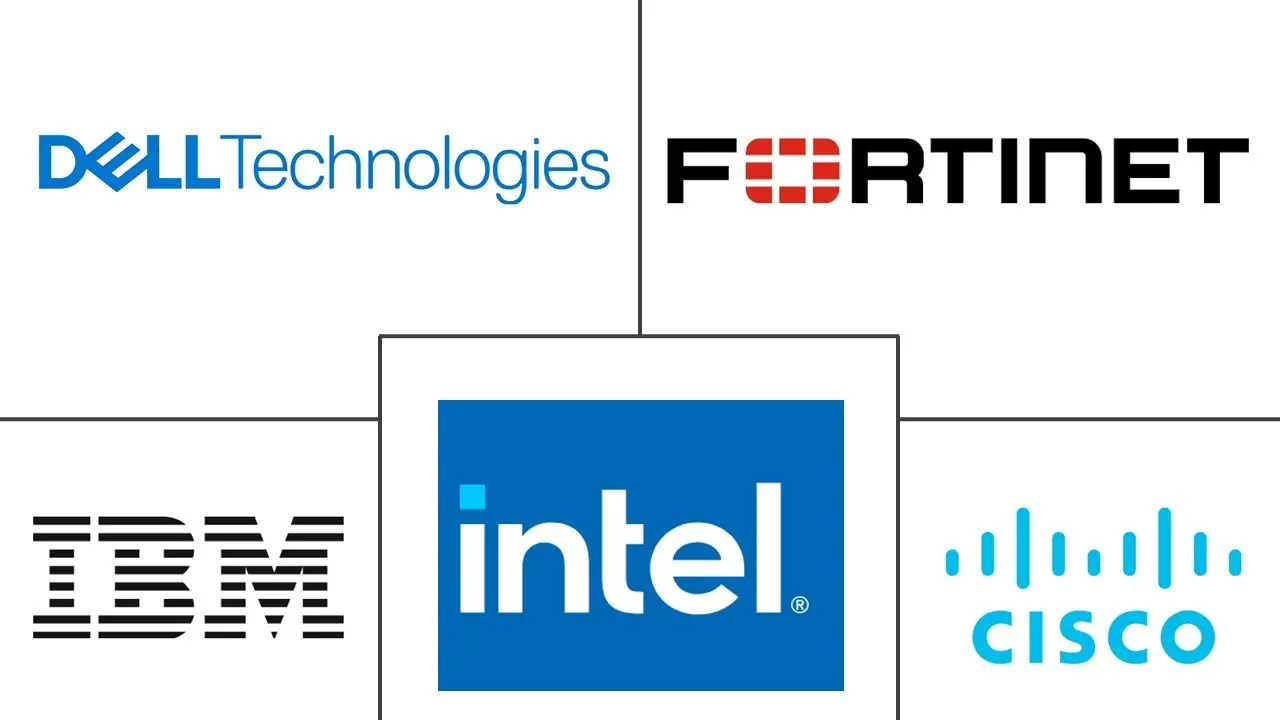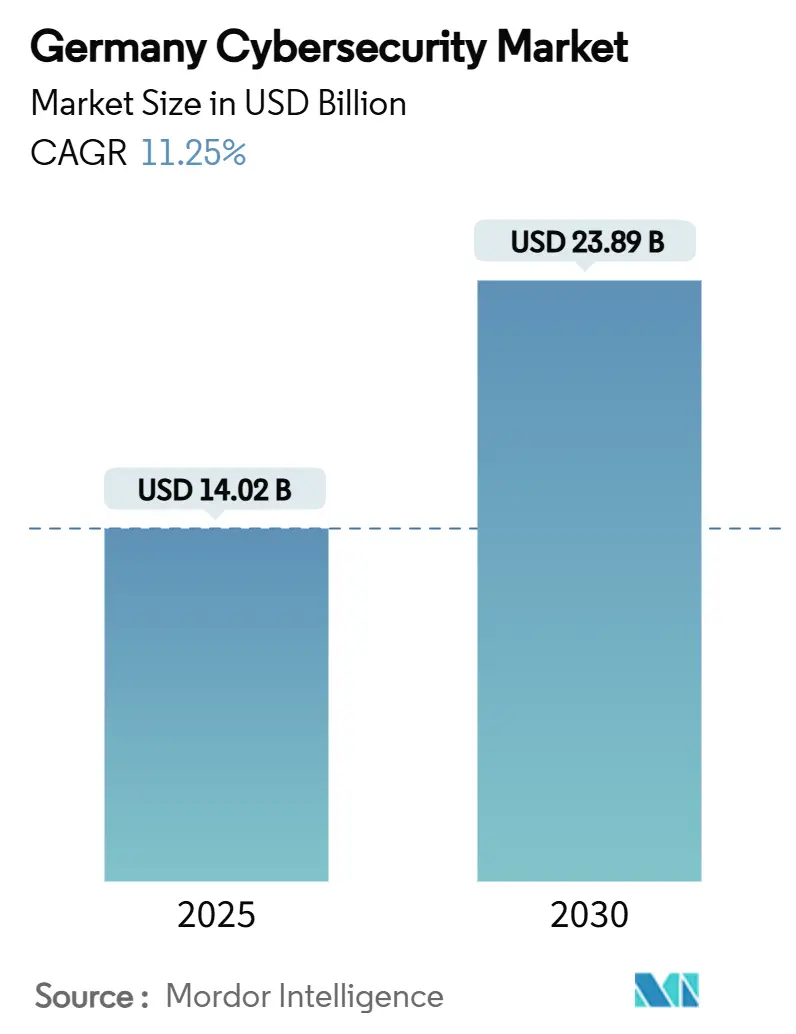
Germany Cybersecurity Market Analysis by Mordor Intelligence
The German Cybersecurity market size reached USD 14.02 billion in 2025 and is projected to advance to USD 23.89 billion by 2030, reflecting an 11.25% CAGR. Across 2024, the Federal Office for Information Security (BSI) logged 72,000 incident reports, a 21% jump on the prior year, while its Produkt-KOMPASS registered 24,531 published vulnerabilities, 15% of which were labelled critical [1]Federal Office for Information Security, “BSI Lagebericht 2024,” bsi.bund.de. Fresh statutes—most notably the NIS2 Implementation and Cyber Security Strengthening Act, the Digital Operational Resilience Act and BaFin’s updated IT requirements—unlock EUR 7.4 billion of compulsory outlays between 2025 and 2027. Oversight is tightening in parallel; 68% of DAX constituents created a board-level cybersecurity committee in 2024, up from 42% in 2022. These governance moves encourage earlier budget sign-off and embed protection lines within core IT capex across the German Cybersecurity market.
The Federal Statistical Office reported cloud use by 69% of companies in 2024, compared with 54% in 2021. Sovereign-cloud contracts inside public agencies expanded 27% last year as ministries tightened domestic-data-residency rules. Organizations also fuse AI and protection budgets under single steering committees, and that integration is expected to reinforce spending momentum across the German Cybersecurity market.
Key Report Takeaways
- By offering, solutions captured 66.4% of the German Cybersecurity market share in 2024, while managed security services (MDR, SOC-aaS) are projected to deliver the fastest 18.5% CAGR through 2030.
- By deployment mode, on-premise and private-cloud installations held 53.2% of the German Cybersecurity market size in 2024, yet public-cloud security is advancing at a 16.8% CAGR through 2030.
- By end-user vertical, transportation and connected mobility is set to expand at 19.7% CAGR between 2025 and 2030, outpacing banking, financial services and insurance’s 18.7% revenue slice in 2024.
- By end-user enterprise size, large enterprises accounted for 71.9% of spend in 2024; SMEs, however, are forecast to lift their portion of the German Cybersecurity market size at a 17.4% CAGR and approach a 36% share by 2030.
Germany Cybersecurity Market Trends and Insights
Drivers Impact Analysis
| Driver | (~) % Impact on CAGR Forecast | Geographic Relevance | Impact Timeline |
|---|---|---|---|
| Cloud-native application expansion in public sector and healthcare | +2.3% | Nationwide, urban centres | Medium term (2-4 years) |
| OT/ICS security urgency amid Industrie 4.0 roll-outs | +2.1% | Industrial regions | Medium term (2-4 years) |
| 5G and connected-mobility infrastructure growth | +1.7% | Transport corridors | Long term (≥ 4 years) |
| Cyber-insurance requirements | +1.4% | Nationwide | Short term (≤ 2 years) |
| Regulatory compliance mandates (NIS2, DORA, BaFin IT rules) | +1.9% | Nationwide | Short term (≤ 2 years) |
| AI-driven threat detection and response automation | +1.6% | Nationwide, large-enterprise hubs | Medium term (2-4 years) |
| Source: Mordor Intelligence | |||
Cloud-native application expansion in public sector and healthcare
Germany’s Online Access Act mandates digital delivery of 575 federal and municipal services by 2026. By December 2024, 41% of those services already ran on Open Telekom Cloud[2]Federal IT Cooperation, “Onlinezugangsgesetz Dashboard,” fitko.de. University hospitals raised hybrid-cloud storage to 94 petabytes over the year to archive imaging datasets. All new workloads must conform to the BSI C5 security framework, whose list of certified providers grew from 23 to 34 during 2024. Faster certification lowers procurement friction and fuels additional migrations, translating directly into higher license and consulting demand across the German Cybersecurity market.
OT/ICS security urgency amid Industrie 4.0 roll-outs
The VDMA reported that smart-sensor adoption reached 71% of production lines in 2024. IW Cologne pegged average downtime costs at EUR 290,000 per hour in automotive plants. Asset-discovery platforms now map 2.3 million critical industrial components nationwide, underpinning passive-monitoring adoption. By integrating cyber safeguards in overall-equipment-effectiveness calculations, manufacturers shift budgets from discretionary IT to mandatory operational protection, tilting revenue towards industrial-grade solutions inside the German Cybersecurity market.
5G and connected-mobility infrastructure growth
5G coverage reached 93% of the population in 2024, with 18,000 standalone cells live. Connected cars consumed 25 GB of data each month, double 2023 traffic. ENISA attributes 62% of European 5G incidents to signaling-layer flaws. As bandwidth demands rise, radio-access security becomes non-negotiable for fleet managers and road authorities, stimulating encryption and anomaly-detection uptake across the German Cybersecurity market.
Cyber-insurance requirements
Cyber-insurance premiums climbed 45% to EUR 723 million in 2024, even as the sector’s loss ratio worsened to 86%. Zurich Germany rejected 59% of applicants lacking multi-factor authentication. Insurers now behave like external auditors, issuing control checklists that firms must satisfy before cover is granted. Compliance with those checklists pushes security standardization and broadens spending, thereby accelerating growth in the German Cybersecurity market.
Restraint Impact Analysis
| Restraint | (~) % Impact on CAGR Forecast | Geographic Relevance | Impact Timeline |
|---|---|---|---|
| Shortage of qualified cybersecurity professionals | –2.2% | Nationwide | Medium term (2-4 years) |
| Budget limitations across the Mittelstand | –1.5% | Rural and small-town areas | Short term (≤ 2 years) |
| Data-sovereignty concerns limiting public-cloud adoption | –1.2% | Nationwide | Medium term (2-4 years) |
| Federal procurement fragmentation | –0.8% | Administrative centres | Short term (≤ 2 years) |
| Source: Mordor Intelligence | |||
Shortage of qualified cybersecurity professionals
Germany entered 2025 with 96,300 open IT-security positions, 25% higher than a year earlier. Senior SOC analysts in Munich command average pay of EUR 96,000, 57% above 2019 levels. Although 28 universities award specialist degrees, only 3,400 graduates enter the workforce annually, covering 7% of demand. Scarcity hardwires elevated wage floors into corporate budgets and directs spending towards automation, SOC-as-a-service and managed detection, which tempers margins yet supports service-provider revenues in the German Cybersecurity market.
Budget limitations across the Mittelstand
KfW notes that 83% of SMEs retain fewer than three dedicated IT staffers. Bitkom values average cybercrime losses at EUR 95,000 per SME in 2024, but security budgets rose just 6% versus 13% among large enterprises. Subscription-priced MDR contracts under EUR 2,000 per month now account for 31% of new listings on the BSI marketplace. Lower-tier packaging expands addressable demand yet compresses ticket sizes, trimming near-term growth inside the German Cybersecurity market.
Segment Analysis
By Offering: solutions dominate yet services accelerate
Solutions accounted for 66.4% of 2024 German Cybersecurity market share, equal to USD 9.3 billion, while managed security services produced USD 3.6 billion and are pacing an 18.5% expansion curve. Companies also bought 164,000 BSI-certified next-generation firewalls, a 14% shipment gain. Service revenue is increasingly usage-based; Deutsche Telekom said that 42% of 2024 security bookings were metered rather than fixed-fee. Aligning provider incentives with live threat conditions ensures continuous optimisation and long-term stickiness across the German Cybersecurity market.
MSS engagement is further fuelled by central government placing EUR 680 million of SOC framework orders in 2024, which broadens vendor scale. The growing reliance on software-defined perimeters and zero-trust pilots requires 24/7 policy tuning unavailable in most internal teams, accelerating demand for outsourced SOC capacity.
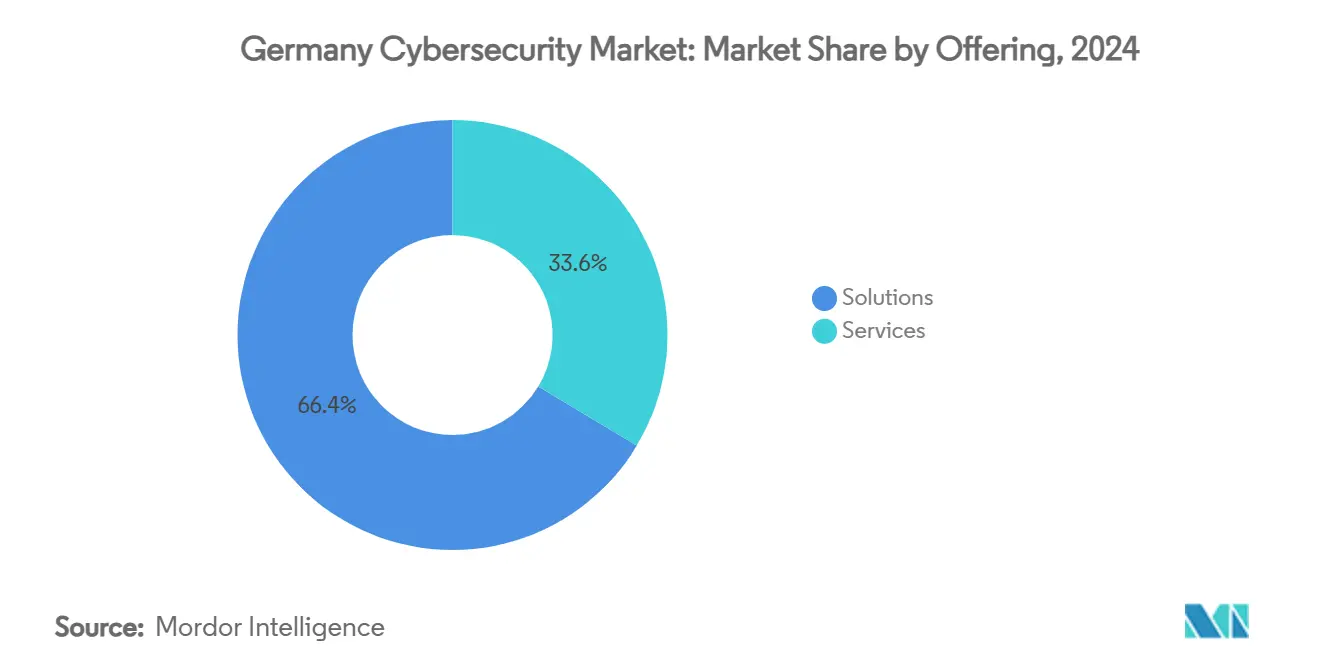
By Deployment Mode: sovereignty bias sustains hybrid demand
On-premise and private-cloud instances retained 53.2% of the German Cybersecurity market size in 2024, or USD 7.4 billion, even as public-cloud security exhibits a 16.8% CAGR. Eurostat shows 46% of German firms storing some data in the public cloud, yet only 11% entrust core financial records. Capgemini measured an 18% premium for locally hosted services, but 58% of adopters accept the higher price.
Eco e.V. estimates that 72% of enterprises operate two SIEM platforms during transition phases. Vendors that unify on-premise and cloud telemetry registered 41% new ARR growth in 2024. This dual-stack reality entrenches complexity, favouring extensible platforms over point products and reinforcing the sovereign-first ethos guiding the German Cybersecurity market.
By end-user enterprise size: SME momentum builds
Large enterprises represented 71.9% of spend in 2024, yet SMEs are forecast to lift their share of the German Cybersecurity market size from 28% to 36% by 2030 on the back of aggressive vendor bundling. Only 39% of SMEs hold ISO 27001 certification, though 61% plan attainment within two years. Competitive tendering shaved SME prices by 22% on CyberCompare’s marketplace. Transparent pricing expands latent demand and boosts entry-level MDR and cloud-backup volumes.
Large enterprises devote 9% of their IT budgets to security, and 73% intend a further 10% uplift for 2025, chiefly on identity-governance and software-bill-of-materials tooling. That regulatory-driven increase secures a broad opportunity spectrum inside the German Cybersecurity market.
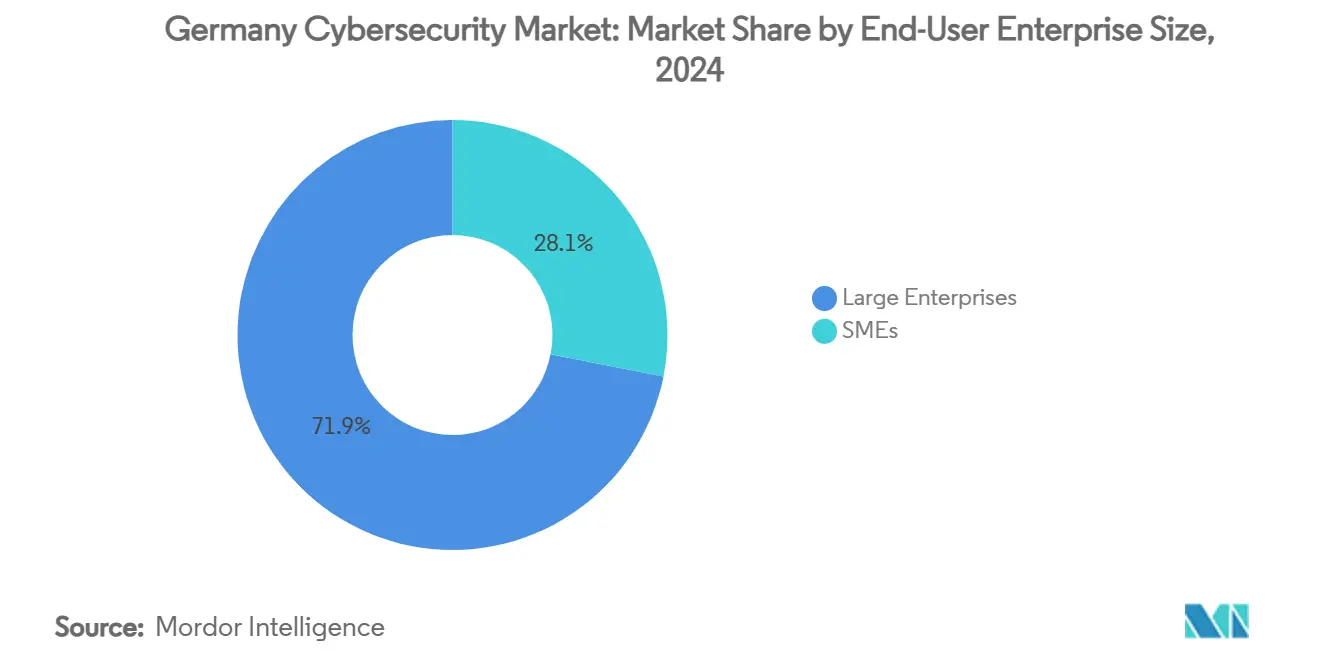
By End-user Vertical: mobility outpaces financial incumbents
Banking, financial services and insurance generated EUR 2.6 billion of spend and held an 18.7% share in 2024. Supervisory pressure trimmed average response times to 26 hours. Transportation and connected mobility logged EUR 1.1 billion but is projected to advance at a 19.7% CAGR as over-the-air update platforms expanded 120% in deployments. Certification bodies such as TÜV Rheinland serve as gatekeepers, nudging suppliers toward pre-cleared frameworks and steering incremental revenue into the German Cybersecurity market.
Hospital-sector investment reached EUR 1 billion, powered by Hospital Future Act grants that earmark 30% of program funding for IT security. Manufacturing and defence together spent EUR 2.2 billion following a 42% jump in critical-infrastructure incident declarations, while public-sector agencies lifted commitments 14% to EUR 1.4 billion as central SOC roll-outs scaled.
Geography Analysis
Regional demand clusters align with industry footprints. North-Rhine-Westphalia and Baden-Württemberg house automotive and machinery corridors where OT security spending matches Industrie 4.0 modernization. Those states accounted for the bulk of the 2.3 million mapped industrial assets, anchoring passive-monitoring and network-segmentation orders. Bavaria’s technology belt funnels budgets into MSS and identity-governance platforms, supported by deep talent pools around Munich.
Public-sector cloud migrations concentrate in Berlin, Bonn and other federal administrative hubs. The Open Telekom Cloud hosts 41% of mandated digital services, and ministries prioritise German data residency, reinforcing sovereign-first procurement patterns. Eastern states adopt cloud-native applications more slowly, partly due to talent scarcity, yet Hospital Future Act grants deliver earmarked funds to regional health networks, widening cyber-resilience coverage.
Transport corridors linking Hamburg–Bremen, the Rhine-Ruhr axis and the Munich–Stuttgart stretch underpin 5G security spend. ENISA data on signalling vulnerabilities intensifies security requirements for smart-road operators. As connected-vehicle platforms double annual bandwidth, encryption, network-slicing and anomaly-detection layers are embedded from project inception, deepening regional wallet share across the German Cybersecurity market.
Competitive Landscape
Domestic champions and global brands occupy a supplier ecosystem that remains moderately consolidated. Deutsche Telekom’s security arm processed 45 billion daily events through AI analytics in 2024 and lifted revenue 30% to EUR 313 million[3]Deutsche Telekom AG, “Annual Report 2024,” telekom.com. SAP bundled zero-trust extensions into 62% of new Rise-with-SAP cloud deals, showcasing potent cross-sell leverage. Secunet recorded EUR 393 million in 2023 sales, with 80% derived from VS-NfD-certified projectsCertification grants local vendors pricing power, sustaining premium margins inside the German Cybersecurity market.
Acquisitions continue to redraw boundaries. VINCI Energies absorbed Fernao and its EUR 140 million revenue stream to broaden Axians’ compliance-service suite. Sophos agreed to buy Secureworks for USD 859 million, expanding its SIEM and identity-threat-detection footprint. These moves aim to fill product gaps and secure enterprise accounts as German Cybersecurity market requirements broaden.
Recruitment pressures spur ecosystem collaboration. Two-thirds of vendors participate in university talent-sharing schemes backed by the German-Israel Cyber Dialogue. Partnerships extend into joint innovation labs that focus on OT analytics, sovereign-cloud controls and automated compliance reporting. Buyers increasingly assess vendor resilience by the breadth of such alliances, reinforcing relationship capital as a differentiator across the German Cybersecurity market.
Germany Cybersecurity Industry Leaders
-
IBM Corporation
-
Cisco Systems Inc
-
Dell Technologies Inc.
-
Fortinet Inc.
-
Intel Security (Intel Corporation)
- *Disclaimer: Major Players sorted in no particular order
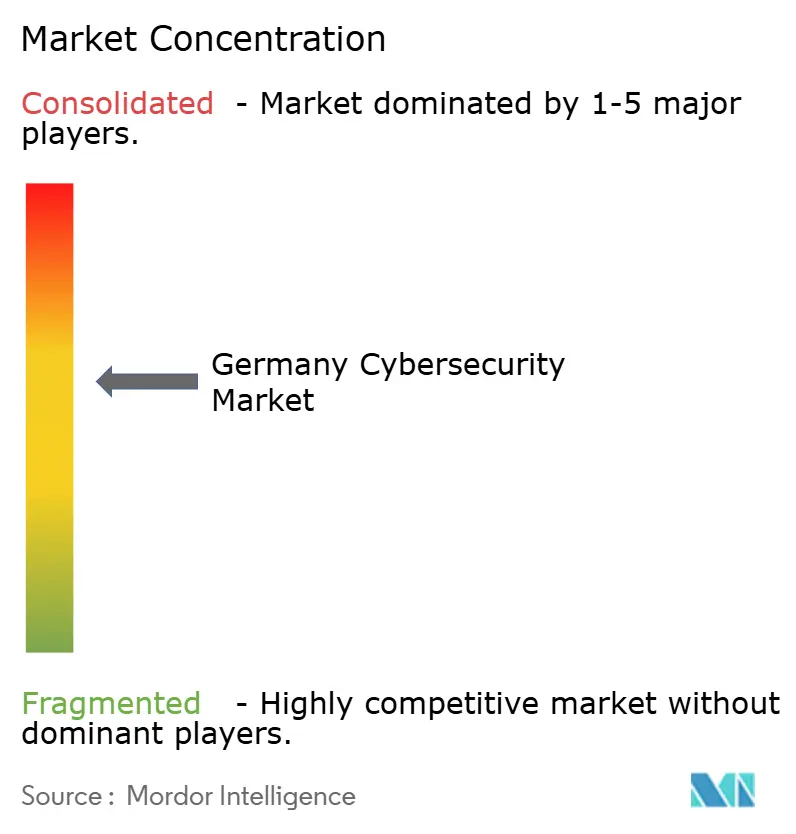
Recent Industry Developments
- January 2025: Deutsche Telekom unveiled Magenta Security on Net, confirming a 2025 commercial launch; the suite delivers SIM-based zero-touch protection and embeds SASE controls.
- November 2024: Schwarz Group and Google agreed to supply sovereign productivity services hosted on STACKIT with client-side encryption.
- October 2024: Sophos signed to acquire Secureworks for USD 859 million, adding identity-threat detection and next-generation SIEM.
- August 2024: VINCI Energies completed its Fernao takeover, broadening Axians’ NIS2 consulting capacity.
Germany Cybersecurity Market Report Scope
Cybersecurity solutions help an organization monitor, detect, report, and counter cyber threats, which are internet-based attempts to damage or disrupt information systems and hack critical information using spyware, malware, and phishing.
The Germany cybersecurity market is segmented by offerings (solutions [application security, cloud security, data security, identity access management, infrastructure protection, integrated risk management, network security, end-point security, and other solution types] and services [professional services and managed services]), by deployment (On-premise, and cloud), by organization size (SMEs, large enterprises), by end-user vertical (BFSI, healthcare, IT and telecom, industrial and defense, retail, energy and utilities, manufacturing, and other end-user industries). The market sizes and forecasts are provided in terms of value in (USD) for all the above segments.
| Solutions | Application Security |
| Cloud Security | |
| Data Security | |
| Identity and Access Management | |
| Infrastructure Protection | |
| Integrated Risk Management | |
| Network Security Equipment | |
| Endpoint Security | |
| Other Services | |
| Services | Professional Services |
| Managed Services |
| On-Premise |
| Cloud |
| BFSI |
| Healthcare |
| IT and Telecom |
| Industrial and Defense |
| Manufacturing |
| Retail and E-commerce |
| Energy and Utilities |
| Others |
| Small and Medium Enterprises (SMEs) |
| Large Enterprises |
| By Offering | Solutions | Application Security |
| Cloud Security | ||
| Data Security | ||
| Identity and Access Management | ||
| Infrastructure Protection | ||
| Integrated Risk Management | ||
| Network Security Equipment | ||
| Endpoint Security | ||
| Other Services | ||
| Services | Professional Services | |
| Managed Services | ||
| By Deployment Mode | On-Premise | |
| Cloud | ||
| By End-User Vertical | BFSI | |
| Healthcare | ||
| IT and Telecom | ||
| Industrial and Defense | ||
| Manufacturing | ||
| Retail and E-commerce | ||
| Energy and Utilities | ||
| Others | ||
| By End-User Enterprise Size | Small and Medium Enterprises (SMEs) | |
| Large Enterprises | ||
Key Questions Answered in the Report
What will the German Cybersecurity market be worth by 2030?
The sector is projected to reach USD 23.89 billion, advancing at an 11.25% CAGR.
Which end-user industry is expanding fastest?
Transportation and connected mobility is forecast to grow at 19.7% CAGR, driven by connected-vehicle and smart-road deployments.
How will the NIS2 Act affect organisations?
NIS2 broadens mandatory risk-management and incident-reporting obligations, compelling thousands of companies to upgrade controls and strengthen board oversight.
Why are managed security services gaining traction among SMEs?
MSS packages provide enterprise-grade protection without hiring scarce full-time specialists and fit predictable subscription budgets.
Page last updated on:
